I didn’t quite manage to see this, but it’s in the outskirts of Caernarfon, on the A4085 Beddgelert road. When I got there, the main part was locked up. There’s also a museum building, (not NT). The seasonal opening hours were Tue-Sun 12.30 to 16.30. Another part of the site is across the road, and IIRC can be accessed anytime.
Looks like it would be worth a look if you are in Caernarfon. You can park in the road.
Category: Museum
Museums and collections
Crossness pumping station, London
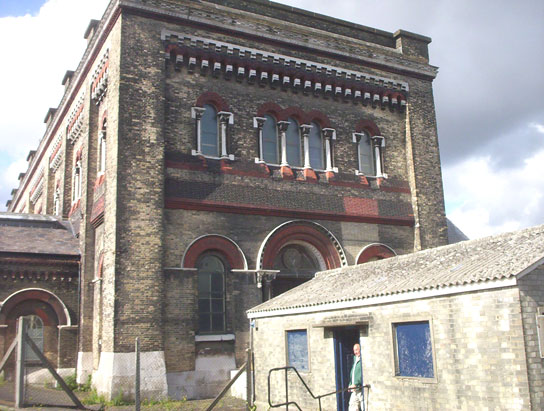
The Crossness Pumping Station was built by Sir Joseph Bazalgette as part of Victorian London’s urgently needed main sewerage system. It pumps sewage from a low intercepting sewer up to the level of the tidal Thames. The Beam Engine House is a Grade 1 Listed Industrial Building constructed in the Romanesque style and features some of the most spectacular ornamental Victorian cast ironwork to be found today. It also contains the four original pumping engines (although the cylinders were upgraded in 1901), which are possibly the largest remaining rotative beam engines in the world, with 52 ton flywheels and 47 ton beams.
The journey there underlinined the advisability of getting up early if one wants to visit Cross Ness. It was a chapter of delays. I left the house at 7.30 AM, but the first train had a fault so got the next half an hour later, which was late at Euston because of speed restrictions. Got to Abbey Wood station at 10.40am, but found a long queue waiting for the courtesy minibus and could not get on one till over half an hour later. At the site there was a long queue to get into the buildings, then another queue to pick up a hard hat and enter the Pump Engine House, so didn’t get in there till 12.30.
The interior is impressive, with four huge engines in place and accessible from three levels. The octagon of painted ironwork only encloses a small part of the floor area, by the way. One engine is completely restored and running on steam, another in bits and the other two untouched. Some ironwork is re-painted in bright colours, while some sections have been left dull and rusty. The beam floor runs the whole length and width of the building and allows access to all the engine beams and the top of the Octagon. There are views out over the site and the Thames. There isn’t so much to see in the basements asides from some very rusty pipes and some shiny parts of the restored engine, Prince Consort. To one side is the Triple Expansion Engine House, which now is mostly empty. From the Beam Engine floor level and old entrance, it looks like an alarmingly big and deep hole with some rusting pipes and machinery in the bottom. Apparently two old diesel pumps are down there.
I came out after an hour, having seen and tried to photograph everything, and to let someone else in. I had a coffee and roll in the unusually cheap cafe, before visiting the workshop building and the former valve house, and taking some more photos. The brick architecture of the whole complex is quite worth seeing, with its arches and milticoloured bricks.
There are/were a few steaming days in 2011 when the site was open to the public. I visited Cross Ness pumping station on Open House London day, 18 Sept 2011. The engine house is on the far side of the large Thames Water site, 2Km from Abbey Wood railway station. A courtesy minibus is laid on, or you can drive there. Adequate car parking is provided. Watch the website http://www.crossness.org.uk/
Done here and wondering what else you could do? There are some abbey ruins near the railway station, or you could take a B11 bus to the NT’s “Red House” in Bexleyheath.
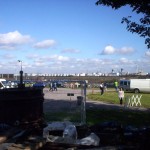
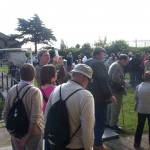

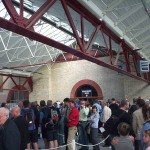
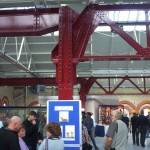
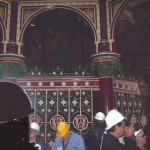
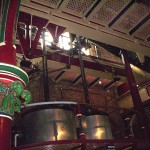
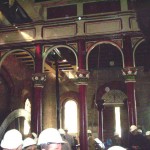
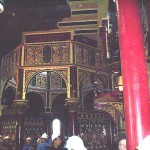


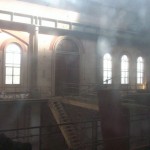



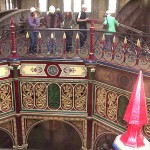

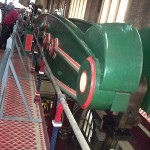



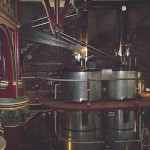

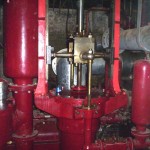
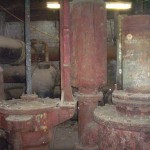
Thames Barrier, Greenwich, London
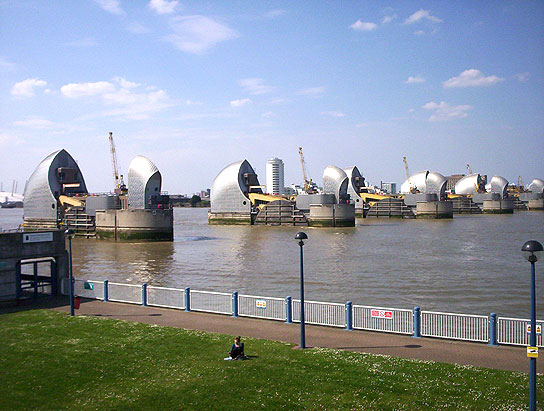
The Thames Barrier, with its striking stainless steel sails, was an iconic construction project, completed in 1984. It is the second largest movable barrier in the world, and protects central London against tidal flooding. It is raised increasingly often to protect London against high tides.
Besides looking at the barrier itself, visitors can pay a modest fee to go inside a small information centre (Thurs-Sun) which contains an interesting exhibition. When I visited, the viewpoint café above it was shut, but there was a temporary one across the car park. If you go, don’t miss the exhibition. When I lived in London the Barrier was under construction, but I never went to have a look.
Visitors can reach the site by walking to Unity Way from the A206 along a dismal industrial road, or through a small park. There is a pay and display car park on site.
National Maritime Museum, Greenwich, London
Formally, the Queen’s House and the Royal Greenwich Observatory are part of the National Maritime Museum. The whole are set in Greenwich Park, in the Greenwich World Heritage area.
Maritime Galleries: It’s difficult to explain what the NMM contains without simply referring you to the website, but besides artefacts ranging from buttons to 10-ton anchors there are themed galleries devoted to such topics as trade or exploration, slavery, warships, etc. There is an increasing amount of interactive stuff, including the facility to collect images on a smartcard and look them up later. For the serious researcher, the Museum has a library and archives. The fusty rows of ship models that I recollect from 2002 have largely been banished.
There is a great deal inside for the interested visitor to see.
Queen’s House: The building itself is of some architectural importance as England’s first Classical building, finished in 1638. It was designed by Inigo Jones. A notable feature is the 40ft x 40ft cubical Great Hall on the northern side. The house was originally built in two halves bridging over a main road, but the middle sections have been partially filled in. It houses the NMM’s painting collection, which has a wider scope than one might expect. Various galleries cover national art, the Royal Hospital School, historic Greenwich, the Tudors, and Dutch marine artists.
The Queens House is well worth a visit if you are interested in art.
Royal Observatory – see separate entry.
Most parts of the complex are free admission, but there is a significant charge for admission to the Observatory, to the annoyance of many visitors who just want to be photographed standing on the Greenwich Meridian.
Firepower – Royal Artillery Museum, Woolwich, London
The Royal Artillery Museum is hosted at the historic Royal Arsenal site beside the Thames at Woolwich. On display are a large number of guns and gun carriages ranging from medieval up to post WWII, together with exhibitions which tell the story of artillery, scientific discoveries made through warfare and human stories of courage and endeavour. The ‘Field of Fire’ audio-visual show puts visitors in the midst of battle as shells whiz overhead and guns roar. A world-class collection of artillery and associated weapons, uniforms, drawings, displays of diaries and medals records some 700 years of world artillery history.
The Royal Arsenal site itself is worth a stroll, with its wide spaces, many elegant listed buildings, and some modern outdoor sculpture. Less happy was the experience of finding Firepower still shut when it was supposed to be open. Right day? Check. Right times? Check. As a last resort I went to enquire at a café attached to the side of the building, and in the process rousted out the receptionist who didn’t seem to know what time of day it was.
The exhibits were interesting, and there was enough to look at to occupy a couple of hours or more. Building 41 with the large objects collection was not open on the date I visited, but it should be when you visit.
I travelled by train, but if you have to drive, there is a pay & display car park nearby at the Plumstead Road entrance. The Thames Barrier is not far away, and can be reached by bus.
The National Museum of Computing, Bletchley, Bucks
The National Museum of Computing is dedicated to showing the development of computing in its broadest sense, from the pioneering wartime efforts that resulted in Colossus, to the products and systems we use today. Exhibits include the Colossus replica, and some big-iron commercial computers e.g Elliot 803B, ICL 2966, that formerly filled the computer rooms of large companies from the 1960s to the 1980s, and a multitude of personal computers and calculators, including Sinclair, BBC Micro, and Amstrad.
There should be something here to interest everyone who has used computers. Older visitors can go around exclaiming “I used to use one of those!” while younger ones can try out the computer games on the personal computers.
TNMOC is on the same site as Bletchley Park, in block H. Please note that TNMOC now levies an admission charge of £5, and if you only want to visit TNMOC, you don’t need to pay the Bletchley Park admission as well. Currently TNMOC has restricted opening hours.
Bletchley Park, Bucks
The WWII code-breaking centre at Bletchley Park was a well-kept secret for years. When the fact of its existence was de-classified, the buildings on the site became the object of attention, and eventually a Trust was set up to preserve the more noteworthy buildings, establish a museum of codebreaking and explain the significance of what went on at the site. Here, the German Enigma code was broken. During the war, thousands of people were employed here, and there was cutting-edge work in developing machine aids for decryption. The electromechanical “Bombe” was invented to help crack Enigma and the electronic computer “Colossus” was invented to help crack the more difficult “Tunny” teleprinter code.
If you visit, there is a lot to see, and one day might not be enough. Guided tours of the various buildings are available, taking in the Mansion, (an opulent if rather mongrel Edwardian mansion), various brick out-buildings of the mansion, some near-indestructible bomb-proofed concrete huts, and some decaying wooden huts with famous numbers, as well as Bombe and Colossus reconstructions.
Then there is the Museum of Codebreaking, where you can try to get your head around how decrypting Enigma actually worked, and other huts with displays about spies, daily life at Bletchley Park during the war, and so forth. Did you know that British military planes used to carry a pigeon so that the bird could carry a message back if the plane came down? I didn’t.
In addition there are other historic displays that share the Bletchley Park site, from TNMOC – the National Museum of Computing, the cine projector museum with mini cinema and newsreel shows, the display of ship models, and others. These ‘other’ groups have their own opening times – check websites.
There is also a series of lectures, which explore war and codebreaking topics in some depth.
Also, there is a miscellany of Events, seemingly ranging from parades of military vehicles to almost anything else.
If you are interested in history, war, or codebreaking, you should find something to interest you here.
Bletchley Park is open daily, but this does not apply to associates such as TNMOC, so check before travelling. Parts of the mansion may be in use for commercial activities on any day except Sundays.
Bletchley Park admission is not expensive considering the amount to be seen, and permits repeated re-admission for 12 months.
Please note that there is a £3 charge for parking in the grounds. Bletchley Park entrance is about 100 yards from Bletchley railway station.
Killerton, Devon
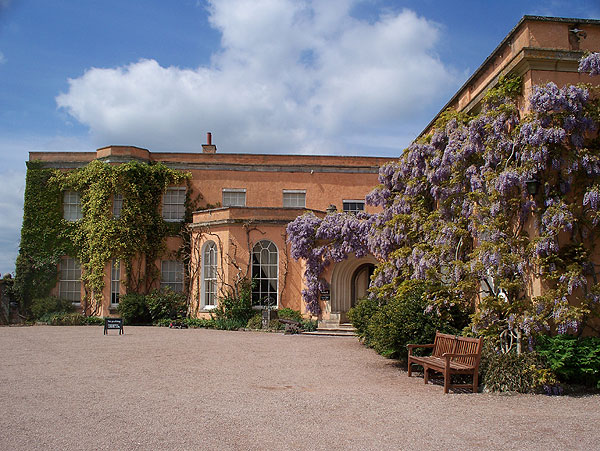 National Trust.
National Trust.
The house was built in 1778-9 but was considerably expanded in the early nineteenth century and again in Edwardian times. Elsewhere are magnificent stone stables and a Victorian Norman Revival chapel. The house is unpretentious outside, but inside downstairs has some grand rooms. The contents reflect country house life in the 1930’s. Upstairs is the noted costume collection of Paulise de Busch. Outside, to one side of the house and above it, are magnificent gardens. The former walled garden is now the car park. Nearby is a large Chapel.
The house stands in a large estate, and elsewhere on it are the Marker’s Cottage (NT) and Clyston Mill (NT), and Budlake Old Post Office (NT). I don’t recall that I saw these, but they have separate entries in the NT guidebook.
I recall that this was rather a tedious place to get to, despite its proximity to Exeter. No major roads run near the estate.



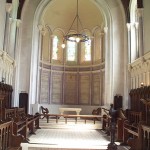
Hartland Quay, Devon
This is a dramatic stretch of rocky coast with high cliffs, where ships used to run aground in large numbers, with much loss of life and property. Despite modern engines and navigation aids, they occasionally still do…
The land around the Quay is privately owned, and one usually has to pay a small charge to drive onto it and park. There is a parking area halfway down, if you don’t want to drive all the way down and up again. Down below is a hotel with public bar, a small museum with exhibits about wrecks, and an area of shore where the harbour used to be before it was demolished by storms. On the beach in the other direction there were some rusty bits of ship lying about.
It’s worth spending a few hours here, to look at the view, look down on any wrecks, visit the wreck museum, have a drink, and maybe paddle from the beach.
If you want more to do, in the same area are other look-out points, e.g. Hartland Point, and also the Hartland Abbey estate. There are also coastal paths.
Arlington Court, Devon
National Trust.
The house has a plain exterior of grey stone, enlivened only by a pillared single-story porch. Inside, it’s totally different, with a Victorian interior decorated with boldly pattered and colourful wallpaper, coloured classical columns, and mahogany furniture, and cluttered with display cabinets overflowing with all sorts of collectible objects. With many acquisitions the Trust has the headache of what to fill the house with once they have acquired it, but here a lot had to be cleared out so that visitors could get around the rooms.
Downstairs is the stairway hall, and a long gallery extending along the south front. Other rooms contain collections of objects including model ships, tea caddies and paperweights. Upstairs are more rooms and displays.
Outside there are shady lawns, a small formal garden, a church, and a bit further off the colonaded stable block with its noted collection of carriages. As with cars today, in the horse era carriages came in an endless variety of designs, sizes and prices, and the Arlington collection, one of the finest in the country, contains many types. It’s a most interesting collection.
Still further from the house are a lake and woodlands. Arlington is the centre of a thriving agricultural estate.
